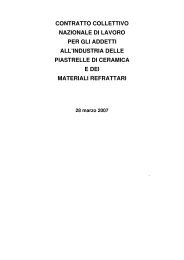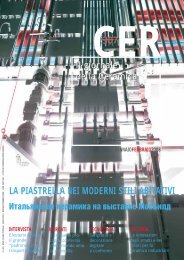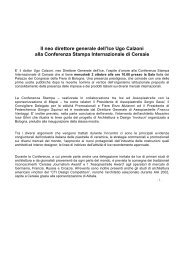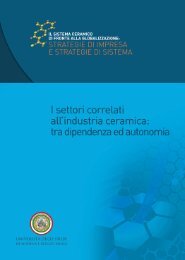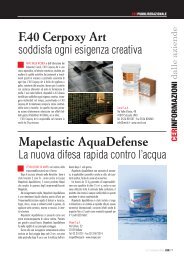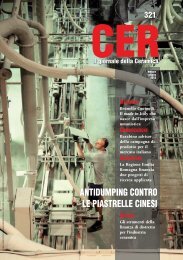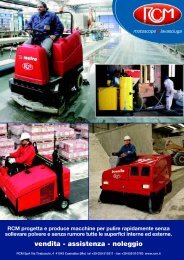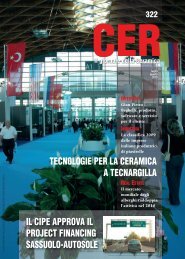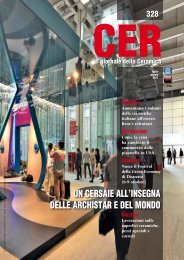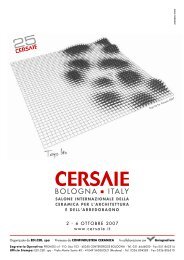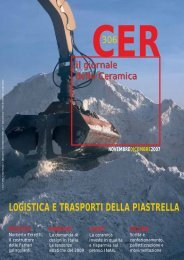Cer_318_completo xweb.pdf - Confindustria Ceramica
Cer_318_completo xweb.pdf - Confindustria Ceramica
Cer_318_completo xweb.pdf - Confindustria Ceramica
You also want an ePaper? Increase the reach of your titles
YUMPU automatically turns print PDFs into web optimized ePapers that Google loves.
CEFLA IMPIANTI GROUP<br />
Via Selice Provinciale 23/a - 40026 Imola (BO)<br />
Tel 0542 653111 - Fax 0542 653129<br />
www.ceflaimpianti.com - ceflaimpianti@cefla.it<br />
Impianti di cogenerazione<br />
Specializzata nella realizzazione d’impianti di cogenerazione,<br />
installando unità di generazione combinata di energia<br />
elettrica e calore, anche alimentati a olio vegetale, Cefla<br />
Impianti - divisione del Gruppo Cefla - ha promosso e<br />
sviluppato, con l’ausilio scientifico del Centro <strong>Cer</strong>amico di<br />
Bologna, un’indagine per verificare l’eventuale inquinamento<br />
di polveri atomizzate a seguito dell’applicazione di un<br />
impianto di cogenerazione con motore endotermico<br />
alimentato a olio vegetale ad un atomizzatore. La ricerca è<br />
nata per valutare come la presenza di polveri contenenti<br />
elementi cromofori nei fumi di scarico possa inquinare un<br />
impasto, variandone il colore o in generale provocando<br />
difetti estetici del materiale dopo cottura.<br />
L’indagine sperimentale condotta in scala di laboratorio ha<br />
adottato il criterio di inquinare artificialmente un impasto da<br />
grès porcellanato, ipotizzando in via cautelativa che tutto il<br />
particolato inquinante venga intrappolato nelle polveri<br />
atomizzate. Per dare maggiore evidenza all’inquinamento,<br />
l’impasto è stato preparato in modo tale da contenere una<br />
concentrazione di polveri inquinanti (raccolte per<br />
gorgogliamento dei fumi in acqua distillata), in particolare di<br />
ferro, di 120 volte superiore a quella prevista. Con l’impasto<br />
inquinato e con quello standard di riferimento sono state<br />
preparate due serie di provini, mediante pressatura,<br />
essiccamento e cottura nelle condizioni del grès<br />
porcellanato.<br />
Le misure colorimetriche effettuate sui provini di materiale<br />
cotto in forno a gradienti, formati coll’impasto standard e<br />
coll’impasto inquinato, non hanno rilevato differenze<br />
significative di colore nell’intervallo di temperatura di<br />
cottura del grès porcellanato (1200-1220°C in forno<br />
industriale, equivalenti a 1220-1240°C in forno a muffola da<br />
laboratorio).<br />
Dall’indagine condotta, nei limiti della sperimentazione in<br />
scala di laboratorio, si può ricavare una bassa o bassissima<br />
probabilità che si manifestino variazioni di qualità del<br />
prodotto (in termini di variazione di colore del materiale<br />
dopo cottura) dovute all’applicazione di un motore<br />
cogenerativo alimentato a olio vegetale direttamente<br />
all’atomizzatore, cioè con immissione diretta dei fumi nella<br />
camera di<br />
essiccamento,<br />
ovviamente dopo<br />
depurazione tramite<br />
il catalizzatore. Ciò<br />
soprattutto per la<br />
grande diluizione<br />
degli inquinanti<br />
nell’impasto<br />
atomizzato.<br />
CERGALLERIA Essiccamento e cottura<br />
Waste heat recovery systems<br />
Cefla Impianti – a division of Cefla Group specialised in waste<br />
heat recovery systems, installing combined electricity and heat<br />
generation units, including those running on vegetable oils - has<br />
promoted and developed a survey supported by the Bologna<br />
<strong>Cer</strong>amic Center, to verify the pollution of atomised powders<br />
caused by the application of a waste heat recovery system with<br />
an endothermic motor running on vegetable oil and a spray<br />
drier. The intention of the research was to assess whether<br />
powders containing chromospheres in the exhaust fumes will<br />
pollute a ceramic body, changing its colour or causing general<br />
aesthetic faults in the material after firing.<br />
The research conducted in the laboratory was based on the<br />
criteria of artificially polluting a porcelain stoneware ceramic<br />
body, cautiously assuming that all of the polluting particulate is<br />
trapped in the atomised powders. In order to emphasize the<br />
pollution, the ceramic body was prepared so it contained a<br />
concentration of iron particulate polluting powders (collected by<br />
scrubbing the fumes in distilled water) 120 times higher than<br />
required. Two sets of test samples were prepared, one with the<br />
polluted ceramic body and the other with the reference<br />
standard, by means of pressing, drying and firing as for<br />
porcelain stoneware.<br />
The colorimetric analysis of the test samples of materials fired<br />
by gradients, consisting of the standard ceramic body and the<br />
polluted body, did not find any significant differences in colour<br />
for the firing temperature range for porcelain stoneware (1200-<br />
1220°C in an industrial kiln, the equivalent of 1220-1240°C in a<br />
laboratory muffle kiln).<br />
Although the findings are subject to the usual limits of testing<br />
on a laboratory scale, they do point to a low or very low<br />
probability of alterations in product quality (in terms of<br />
alterations in the colour of the material after firing) if a wasteheat<br />
recovery motor running on vegetable oil is fitted directly<br />
onto the spray drier, so the fumes are released directly into the<br />
drying chamber, naturally after purification by means of a<br />
catalyst. This is due especially to the high dilution of the<br />
pollutants in the spray-dried body.<br />
2009 novembre/dicembre CER 91



